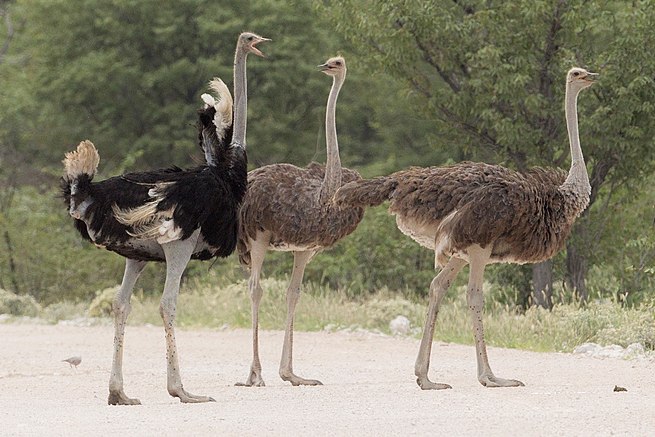
Main Difference
The main difference between Ostrich and Emu is that the Ostrich is a species of large flightless birds and Emu is a largest bird native to Australia.
-
Ostrich
The ostrich or common ostrich (Struthio camelus) is either of two species of large flightless birds native to Africa, the only living member(s) of the genus Struthio, which is in the ratite family. In 2014, the Somali ostrich (Struthio molybdophanes) was recognized as a distinct species.The common ostrich shares the order Struthioniformes with the kiwis, emus, rheas, and cassowaries. However, phylogenetic studies have shown that it is the sister group to all other members of Palaeognathae and thus the flighted tinamous are the sister group to the extinct moa. It is distinctive in its appearance, with a long neck and legs, and can run for a long time at the speed of 55 km/h or even up to about 70 km/h (19 m/s; 43 mph), the fastest land speed of any bird. The common ostrich is the largest living species of bird and lays the largest eggs of any living bird (extinct elephant birds of Madagascar and the giant moa of New Zealand laid larger eggs).
The common ostrich’s diet consists mainly of plant matter, though it also eats invertebrates. It lives in nomadic groups of 5 to 50 birds. When threatened, the ostrich will either hide itself by lying flat against the ground, or run away. If cornered, it can attack with a kick of its powerful legs. Mating patterns differ by geographical region, but territorial males fight for a harem of two to seven females.
The common ostrich is farmed around the world, particularly for its feathers, which are decorative and are also used as feather dusters. Its skin is used for leather products and its meat is marketed commercially, with its leanness a common marketing point.
-
Emu
The emu (Dromaius novaehollandiae) is the second-largest living bird by height, after its ratite relative, the ostrich. It is endemic to Australia where it is the largest native bird and the only extant member of the genus Dromaius. The emu’s range covers most of mainland Australia, but the Tasmanian emu and King Island emu subspecies became extinct after the European settlement of Australia in 1788. The bird is sufficiently common for it to be rated as a least-concern species by the International Union for Conservation of Nature.
Emus are soft-feathered, brown, flightless birds with long necks and legs, and can reach up to 1.9 metres (6.2 ft) in height. Emus can travel great distances, and when necessary can sprint at 50 km/h (31 mph); they forage for a variety of plants and insects, but have been known to go for weeks without eating. They drink infrequently, but take in copious amounts of water when the opportunity arises.
Breeding takes place in May and June, and fighting among females for a mate is common. Females can mate several times and lay several clutches of eggs in one season. The male does the incubation; during this process he hardly eats or drinks and loses a significant amount of weight. The eggs hatch after around eight weeks, and the young are nurtured by their fathers. They reach full size after around six months, but can remain as a family unit until the next breeding season. The emu is an important cultural icon of Australia, appearing on the coat of arms and various coins. The bird features prominently in Indigenous Australian mythology.
-
Ostrich (noun)
A large flightless bird (Struthio camelus) native to Africa.
-
Ostrich (noun)
One who buries one’s head in the sand instead of acknowledging problems
-
Emu (noun)
A cassowary (genus Casuarius). from early 17th c.
-
Emu (noun)
A large flightless bird native to Australia, Dromaius novaehollandiae. from 18th c.
-
Emu (noun)
initialism of electromagnetic unit
“EMU”
-
Emu (noun)
clipping of emulator
